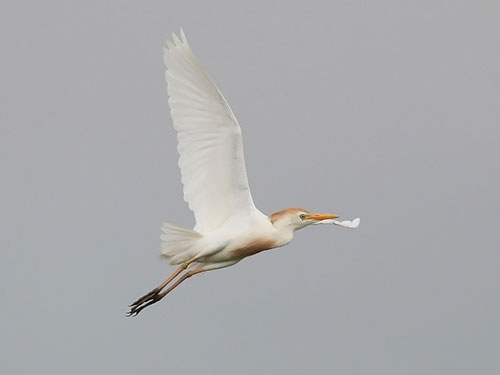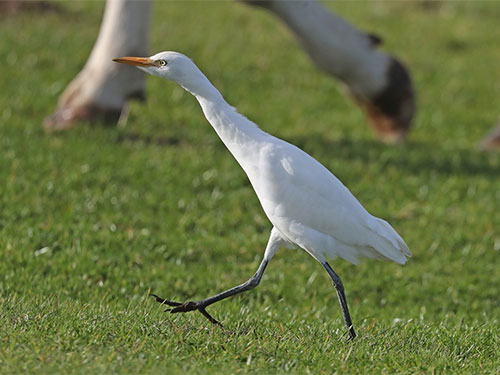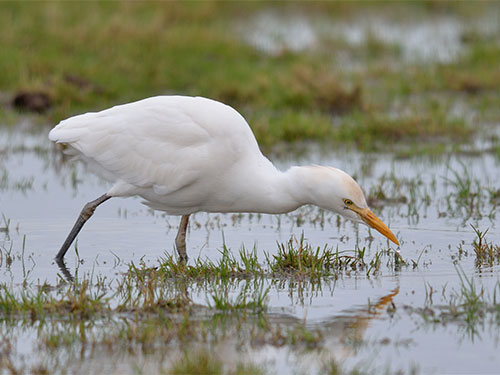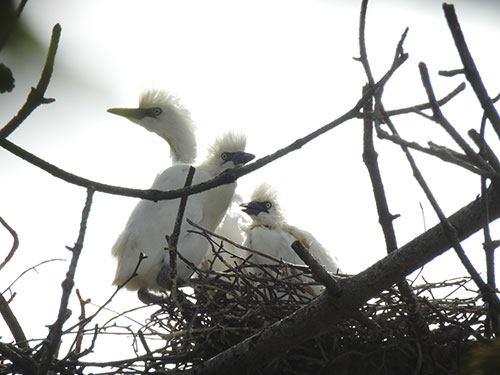


Cattle Egret in breeding plumage
Photo: Martin Casemore

Cattle Egret in non-breeding plumage
Photo: Martin Casemore

Cattle Egret in partial breeding plumage
Photo: Martin Casemore

Three young Cattle Egrets in one of the first Sussex nests this year
Photo: Pete Denyer
Cattle Egrets are small white herons, close in size to Little Egrets, but stockier and shorter-legged, with lovely orange tones to the crown, breast and mantle when in breeding plumage. They are only likely to be confused with Little Egrets, but given the differences in shape you should not have any difficulty as long as you obtain reasonable views.
The name really does suit as they like to forage among cattle, feeding mainly on insects such as grasshoppers. Cattle Egrets are among the great pioneers of the bird world. In the 19th century they moved outwards from their Iberian, North and tropical African range and colonised South Africa and, incredibly, South America. By the 1940s birds had arrived in North America. My 1977 edition of The Birds of the Western Palearctic shows their European range as still confined to the southern Iberian Peninsula and the Camargue in the south of France. I remember being excited to see some for the first time in Gibraltar in 1963 when I was nine years old and attending my eldest brother’s wedding. Since then Cattle Egrets have gradually moved further north across western and central Europe, reaching northern France by 1981 and Italy in 1985. They first bred in the UK in 2008, though not again until 2017. Today, there are hundreds in the UK, with the Avalon marshes in Somerset being a prime site for flocks and breeding birds.
2017 also saw an influx into Sussex, with a record county total of about 19 individuals. Last year, the first colony in Hampshire was established and as this was close to the Sussex border, there seemed to be a good chance that Cattle Egrets would breed in Sussex in 2020. This has indeed happened, with several successful pairs in Pagham Harbour and in the east of the county. One or more pairs attempted to breed in central Sussex too, but these nests appear to have failed. All the nests were in heronries containing Little Egrets. As well as this exciting news, there have been some remarkable concentrations of Cattle Egrets in Sussex this summer, with a record 46 in Pagham Harbour on 24th August and almost 100 in the county as a whole at the time - these totals for what was a scarce enough species in the county for all records to require a description or photo as recently as 2018.
If you would like to see Cattle Egrets in Sussex, you can either search for yourself, starting by looking for herds of cattle in the river valleys and levels, or if you do not have much free time, look at the Recent Sightings page of the Sussex Ornithological Society website, where observers often mention their pleasure at seeing these still rather exotic herons.
What of the future? My guess is that the Sussex population will continue to increase and indeed that other rare herons will become regular breeders in south-east England. Great White Egrets could be next, though the shortage of suitable habitat may limit or prevent colonisation of Sussex by these and other related species such as Purple Heron and Glossy Ibis.
A little anecdote to finish with: I said that identification of Cattle Egret is straightforward, but I found a flock some years ago in Kabul, Afghanistan, when I was working there. The Cattle Egrets we see in Sussex are Western Cattle Egrets, which occur as far east as Iran. In the Indus valley of Pakistan and further east, they are replaced by the almost identical Eastern Cattle Egret, Bubulcus coromandus. I was between the ranges of the two species so although I had found a new species for Afghanistan, I did not know which one it was. Maybe one of the two species is now breeding in Afghanistan, the eastern species being a long-distance coloniser just like the western one.
Mark Mallalieu
mallalieum@gmail.com
Every month it is our aim to highlight a species that is “in-season” and, although not necessarily rare or difficult to identify, has been highlighted by our local recording groups as being somewhat under-recorded and for which new records would therefore be welcomed.
If you or your recording group are aware of species such as this then please contact Bob Foreman.